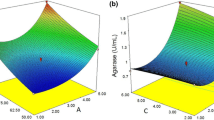Abstract
Microbulbifer strain CMC-5 reportedly degrades multiple polysaccharides including agar. In present study, the agarase from the culture supernatant of Microbulbifer strain CMC-5 pregrown in artificial sea water-based medium containing agar was tenfold concentrated by ultrafiltration. The bacteriological agar-derived oligosaccharides obtained by agarase treatment were observed to depict reducing power, lipid peroxidation inhibition and hydroxyl radical scavenging activities. The oligosaccharides produced from agar by agarase treatment for 6 h demonstrated higher antioxidative activities as compared to agar oligosaccharides produced by 12-h agarase treatment. Further, the agar oligosaccharides demonstrated concentration-dependent augmentation of antioxidative activities. Since agar is a recognized safe food additive, the agar-derived oligosaccharides can be blended with food to augment its antioxidative property. Additionally, the agarase from strain CMC-5 in conjunction with Onozuka R-10 degraded Gracilaria corticata thalli to produce single cell detritus that can be used as aquaculture feed material reducing the dependency on artificial feeds.


Similar content being viewed by others
References
Giordano A, Andreotti G, Tramice A, Trincone A (2006) Marine glycosyl hydrolases in the hydrolysis and synthesis of oligosaccharides. Biotechnol J 1:511–530
Imran M, Pant P, Shanbhag YP, Sawant SV, Ghadi SC (2017) Genome Sequence of Microbulbifer mangrovi DD-13T reveals its versatility to degrade multiple polysaccharides. Mar Biotechnol 19(1):116–124
Vashist P, Nogi Y, Ghadi SC, Verma P, Shouche YS (2013) Microbulbifer mangrovi sp. nov., a polysaccharide-degrading bacterium isolated from an Indian mangrove. Int J Syst Evol Microbiol 63:2532–2537
Ekborg N, Gonzalez JM, Howard MB, Taylor LE, Hutcheson SW, Weiner RM (2005) Saccharophagus degradans gen. nov., sp. nov., a versatile marine degrader of complex polysaccharides. Int J Syst Evol Microbiol 55:1545–1549
Jonnadula R, Verma P, Shouche YS, Ghadi SC (2009) Characterization of Microbulbifer strain CMC-5, a new biochemical variant of Microbulbifer elongatus type strain DSM6810T isolated from decomposing seaweeds. Curr Microb 59:600–607
Wang P, Jiang X, Jiang Y, Hu X, Mou X, Li M, Guan H (2007) In vitro antioxidative activities of three marine oligosaccharides. Nat Prod Res 21:646–654
De Souza MCR, Marques CT, Dore CMG, da Silva FRF, Rocha HAO, Leite EL (2007) Antioxidant activities of sulfated polysaccharides from brown and red seaweeds. J Appl Phycol 19:153–160
Chen HM, Zheng L, Yan XJ (2005) The preparation and bioactivity research of agaro-oligosaccharides. Food Technol Biotechnol 43:29–36
Chen H, Yan X, Zhu P, Lin J (2006) Antioxidant activity and hepatoprotective potential of agaro-oligosaccharides in vitro and in vivo. Nutr J 5:31–42
Camacho P, Salinas JM, Fuertes C, Delgado M (2004) Preparation of single cell detritus from Laminaria saccharina as a hatchery diet for bivalve mollusks. Mar Biotechnol 6:642–649
Wakabayashi M, Sakatoku A, Noda F, Noda M, Tanaka D, Nakamura S (2012) Isolation and characterization of Microbulbifer species 6532A degrading seaweed thalli to single cell detritus particles. Biodegradation 23:93–105
Camacho AP, Salinas JM, Delgado M, Fuertes C (2007) Use of single cell detritus (SCD) produced from Laminaria saccharina in the feeding of the clam Ruditapes decussatus (Linnaeus, 1758). Aquaculture 266:211–218
Uchida M, Murata M (2002) Fermentative preparation of single cell detritus from seaweed, Undaria pinnatifida, suitable as a replacement hatchery diet for unicellular algae. Aquaculture 207:345–357
Miller GL (1959) Use of dinitrosalicylic acid reagent for determination of reducing sugar. Anal Chem 31:426–428
Wu SC, Wen TN, Pan CL (2005) Algal-oligosaccharide-lysates prepared by two bacterial agarases stepwise hydrolyzed and their anti-oxidative properties. Fish Sci. 71:1149–1159
Stewart RR, Bewley JD (1980) Lipid peroxidation associated with accelerated aging of soybean axes. Plant Physiol 65:245–248
Xue CH, Fang Y, Lin H, Chen L, Li ZJ, Deng D, Lu CX (2001) Chemical characters and antioxidative properties of sulfated polysaccharides from Laminaria japonica. J Appl Phycol 13:67–70
Rupérez P, Ahrazem O, Leal JA (2002) Potential antioxidant capacity of sulfated polysaccharides from the edible marine brown seaweed Fucus vesiculosus. J Agric Food Chem 50:840–845
Zhang Q, Yu P, Li Z, Zhang H, Xu Z, Li P (2003) Antioxidant activities of sulfated polysaccharide fractions from Porphyra haitanesis. J Appl Phycol 15:305–310
Jonnadula R, Ghadi SC (2011) Purification and characterization of β-agarase from seaweed decomposing bacterium Microbulbifer sp. strain CMC-5. Biotechnol Bioprocess Eng 16:513–519
Lin Q, Ou S, Wen Q (2014) In vitro antioxidant activity of feruloyl arabinose isolated from maize bran by acid hydrolysis. J Food Sci Technol 51:1356–1362
Wang FJ, Kang SK, Pan CL, Wu SC (2011) Composition of two seaweed-oligosaccharide-lysates derived from agarase AS-II and their ferrous-chelating antioxidant power. J Mar Sci Technol 19:557–564
Wang J, Jiang X, Mou H, Guan H (2004) Anti-oxidation of agar oligosaccharides produced by agarase from a marine bacterium. J Appl Phycol 16:333–340
Acknowledgements
The authors are grateful to Goa University for providing the research fellowship during the tenure of this work. One of the authors acknowledges the Department of Biotechnology, New Delhi, India, for the DBT-JRF and DBT-SRF awards.
Author information
Authors and Affiliations
Corresponding author
Ethics declarations
Conflict of interest
The authors declare that they have no conflict of interest to publish this manuscript.
Additional information
Publisher's Note
Springer Nature remains neutral with regard to jurisdictional claims in published maps and institutional affiliations.
Significance Statement
In the present study, enzymatically produced agar oligosaccharides depict broad range antioxidative properties that could be used as safe food additives. Additionally, agarase produces SCD from Gracilaria thalli that may be used as feed in aquaculture.
Rights and permissions
About this article
Cite this article
Jonnadula, R., Imran, M., Vashist, P. et al. Production of Agar-Derived Antioxidants and Single Cell Detritus from Gracilaria corticata Using Agarase from Microbulbifer sp. CMC-5. Proc. Natl. Acad. Sci., India, Sect. B Biol. Sci. 90, 73–78 (2020). https://doi.org/10.1007/s40011-019-01082-0
Received:
Revised:
Accepted:
Published:
Issue Date:
DOI: https://doi.org/10.1007/s40011-019-01082-0




